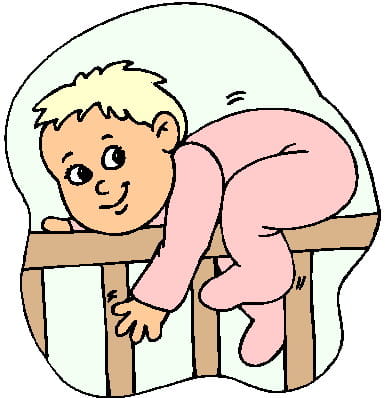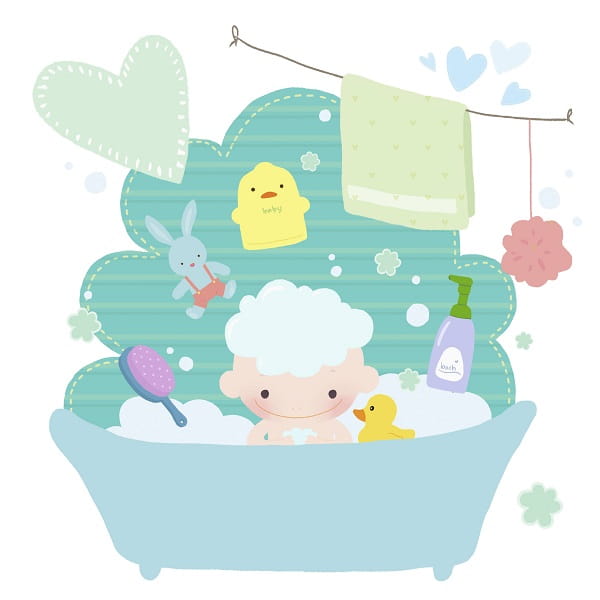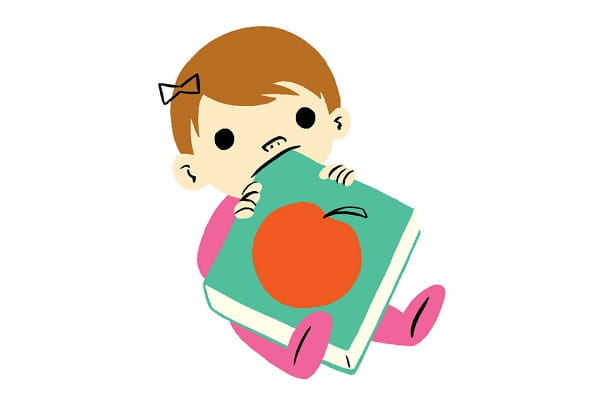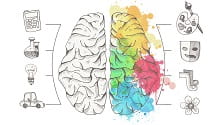Almost there! One more month and the first year will be behind us. And what a year. We, as parents learned so much in this past eleven months, but every day there is something new and unknown to us. Baby is changing every day and the eleventh month is no exception. Good thing there is Google and people to learn from who already passed through it.
Are you interested in some other month of baby’s life? We have covered all months until now and you can find all the articles in the first year of a child’s life section. If you’re just starting with parenting or waiting for the new family member, you can start with the first month of newborn’s life.
Oh, legs! I can use them to reach higher objects!
And this month it became official. The baby started spending most of the time on her two legs. Still not ready to walk but at least standing with holding is her second nature now. She already mastered getting down the bed and couch although there was some regression in the tenth month. But now it’s fine. Like she’s been doing it her whole life.
But this month, our little baby started using her two legs more and more. That is great! Until you find out it is not that great. Now the edges of tables and cabinets are more dangerous. Objects on tables are not out of the reach and oh boy… When we are cranky (usually at evening) and tired, falling from our legs is much worse than just leaning over. We bought protection for the edges but with limited success. She finds it great for chewing and already managed to remove it a couple of times.

But all in all, it’s good progress. It gives a whole new dimension for baby to explore and it’s the last milestone before actual walking. But we won’t hold our breath. It can take many months from first standing on legs until actual walking. But that’s okay. The experts say that there is actually a bigger benefit if the baby crawls longer. Crawling has a positive effect on hand-eye coordination and it positively impacts graphomotor skills in later stages of life.
Crawling Backward aka Moon Crawling
Maybe we really overdid it by listening to Michael Jackson since our baby thinks she can do the “Moonwalk”. Well, she can’t even walk so she must do with “Mooncrawling”.
It’s really funny how she uses her hands to push herself backward until she gets stuck on the wall or table. Especially while holding something in her mouth. We have also covered that cute puppy behavior in the tenth-month article. And why is she doing it when she is perfectly capable of crawling forward? Well, that is also another way of learning and exploring the world around her. She is also learning that she has strong hands that can also be used for moving while the legs are resting. Also, going “from” something is also a possibility, not just going “to” something. And lastly, crawling backward also improves stability and motor skills of the baby while she explores the whole new way of moving through the environment.
Some babies also start to crawl backward before learning how to move forward. That is actually not that uncommon although many parents worry that something is wrong with the baby. Actually, from all that “tummy time” and trying to get up, babies have stronger hands than legs. So that is why it is common they first learn how to push themselves and that is actually what we call crawling backward. If you are in that situation, don’t worry. The baby will soon learn the benefits of legs and start to use them more and more when she sees the difference in movement speed when going forward compared to backward moving.
Fear of the Bath
So the eleventh month brought some unexpected issue with it. And may we say really inconvenient issue. The baby is all of a sudden afraid of bathing.
We are giving a bath every day and we like to do it in the little baby tub. All was great, she loved to bath and we even played games, splish-splashing all the time until all of us were totally wet. She was laughing and it was even one of her favorite parts of the day (eating is still top activity by a large margin).
And one day, everything started as usual until we put her in the bath. That was followed by a hysterical cry full of tears so we had to end the bathing. We thought: “Nevermind” already used to unexpected mood swings. But the next day the same thing. As soon as she touched the bath, terrified cry followed. So, for now, we are doomed to all kind of tactics to wash the child. Most of the time we do it holding her in hands but that is, as I already mentioned, really inconvenient.
So what is with that? Well, another phase. As baby’s brain gets more developed, it perceives things it didn’t before. So that strange thing that I must sit in (water) and that moves erratically, can be such a frightening thing! You probably know there are things that your child is really afraid of. The vacuum cleaner is still arch nemesis of our little baby. We don’t dare to turn it on while she is in the room.

So if you find yourself in the situation where sitting in the bath is not an option anymore, there is a couple of suggestions that can help. First one is patience. It can take a couple of weeks so don’t rush. Rushing can have bigger negative effects on child emotional development so as always, it’s not good to do anything by force. Second thing is to approach the bath gradually. You can first make your child look you interacting with bath and little by little try to get the child to interact with it. First from outside before trying to go in again. Also, using some incentive like interesting toys or bubbles can get baby more interested in the bath.
Nose, ear and…food?
Oh, the places you’ll go! And the places you’ll put stuff in! This month, our girl noticed there are a few more interesting holes on her head. Like her ear. And nose. So why should we put food only into our mouth? And throwing food on the floor is old news, testing gravity and all that. She discovered something new – an ear is a particularly interesting place to push food in.
That makes meals even more interesting. Now we have to watch like eagles so she doesn’t put stuff inside her ear. And we are reasonable we swear! We let her spread it all over her face, hair, and clothing. But ear and nose are forbidden because it can be really dangerous if something gets clogged in there.
But what to do, except repeat no, no, no? You’ll be happy to hear that they’ll grow out of it! Hurray for the most generic advice ever. But seriously, is there anything to help? Well, there are a few things we are trying now – no conclusive results yet.
We are exploring body parts together. She is looking into our ears, we are pointing to it when we listen to music and bringing it closer to “hear” better. Same thing with the nose. Activities like smelling spices, making exaggerated sniffing sounds, pointing to her nose when something smells… The goal is for her to understand the function of those body parts. Hopefully, she’ll also understand that the food is in the domain of the mouth.
Biting phase
The world is so exciting place. It can be even too exciting when you are a baby. Most of the stuff you see and experience is new and intense. That can lead to overstimulation or as any parent knows evening crankiness. As the day goes by, sensory experiences accumulate and can make baby nervous and clingy. That’s where good evening routing kicks in and helps the baby to calm down. Touch is an especially important component, giving a sense of closeness and security. But while you are lovingly snuggling your baby, she bites you! Ouch! What’s with that?
As hard as it may be, it’s advisable not to react by screaming. And trust me, that’s sometimes hard, especially if the baby does it during the breastfeeding. An intense reaction can scare the baby, even lead to a nursing strike. Yelling can also be counterproductive, the baby could like your reaction and start to play a game “bite to get mama to yell”. Not a fun game, let me tell you.
Biting is a normal phase in development and this period is known as “oral” (by some theories) for the reason. It serves many purposes for the baby – it’s a way to express anger and frustration, playful experimentation or just relieve gum pain. It is a very, very common teething sign.

It’s important to remember that babies also have emotions, but unlike us, they don’t know a proper way to express them. Actually, we usually don’t deal with emotions so good ourselves. But babies can’t talk so they really have limited options to vent their anger. Thankfully, it is just a phase (one more!) and it will pass with the development of verbal skills.
It’s important to stay calm and don’t make a huge deal out of it. It’s hard, and I didn’t react properly every time (8 teeth bite can really hurt), but I’m trying. I just remove her from shoulder/breast/whatever she’s biting, say that we don’t bite people and give a teether. Of course, all that probably won’t help much. As we said, this is a normal developmental phase (and it will occur again around 2 years!), so the only thing that will really help is time.
And we’re done with the eleventh month with the baby. Those were some of the important changes that we noticed. There is always more but who would remember all changes on a daily basis. Next time we are closing the year and we’ll describe what new challenges and joys we experienced at the end of the year. So be sure to drop by to find out how the first year ended.
If you’re searching for some great STEM Activities for Kids and Child development tips, you’re in the right place! Check the Categories below to find the right activity for you.

STEM Science
Videos, guides and explanations about STEM Science in a step-by-step way with materials you probably already have at your home. Find new Science ideas.
Read more
STEM Technology
Videos, guides and explanations about STEM Technology in a step-by-step way with materials you probably already have at your home. Find new Technology ideas.
Read more
STEM Engineering
Videos, guides and explanations about STEM Engineering in a step-by-step way with materials you probably already have at your home. New Engineering ideas!
Read more
STEM Math
Videos, guides and explanations about STEM Math in a step-by-step way with materials you probably already have at your home. Find new Mathematics ideas.
Read more
Psychology
Find out all about development psychology topics that you always wanted to know. Here are articles from child psychology and development psychology overall.
Read more
First year of Child’s Life
Following a Child’s development every month from its birth. Personal experiences and tips on how to cope with challenges that you will face in parenting.
Read more